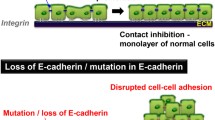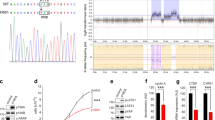Summary
Ataxia telangiectasia is a hereditary pleiomorphic syndrome caused by loss of Atm, a phosphoprotein involved in multiple signaling pathways. Here, we propose a novel role for atm in cultured epithelial cells, namely the regulation of cell growth by contact inhibition. We show that atm is upregulated in epithelial cells reaching confluence. Conditional expression of the PI 3-Kinase domain of atm in non-confluent Tac-2 epithelial cells increases the expression of the anti-proliferative gene Tis-21 and downregulates key cell cycle regulator genes, such as cyclins A, B1, B2, E and E2. Finally, we demonstrate that upregulation of atm, and thus Tis-21, in confluent Tac-2 cells can be inhibited by an E-cadherin antibody blocking specifically homophilic E-cadherin interactions between adjacent cell surfaces. Altogether, these results suggest that atm could participate in a molecular pathway linking extracellular signalling to cell cycle control and may help further clarify the role of Atm in epithelial cell biology and carcinogenesis.
Similar content being viewed by others
References
Rotman G, Shiloh Y (1998) ATM: from gene to functionHum Mol Genet 7(10):1555–1563
Swift (1990) Cancer predisposition of Ataxia-Telangiectasia heterozygotesCancer Genet Cytogenet 46:21–27
Gumy-Pause F, Wacker P, Sappino AP (2004) ATM gene and lymphoid malignanciesLeukemia 18(2):238–242
Easton DF (1994) Cancer risks in A-T heterozygotesInt J Radiat Biol 66(6 Suppl):S177–182
Izatt L, Greenman J, Hodgson S, Ellis D, Watts S, Scott G, Jacobs C, Liebmann R, Zvelebil MJ, Mathew C, Solomon E (1999) Identification of germline missense mutations and rare allelic variants in the ATM gene in early-onset breast cancerGenes Chromosomes Cancer 26(4):286–294
Broeks A, Urbanus JH, Floore AN, Dahler EC, Klijn JG, Rutgers EJ, Devilee P, Russell NS, van Leeuwen FE, van’t Veer LJ (2000) ATM-heterozygous germline mutations contribute to breast cancer-susceptibilityAm J Hum Genet 66(2):494–500
Maillet P, Bonnefoi H, Vaudan Vutskits G, Pajk B, Cufer T, Foulkes W, Chappuis PO, Sappino AP (2002) Constitutional alterations of the ATM gene in early-onset sporadic breast cancerJ Med Genet 39(10):751–753
Chen G, Lee E (1996) The product of the ATM gene is a 370-kDa nuclear phosphoproteinJ Biol Chem 271(52):33693–33697
Watters D, Khanna KK, Beamish H, Birrell G, Spring K, Kedar P, Gatei M, Stenzel D, Hobson K, Kozlov S, Zhang N, Farrell A, Ramsay J, Gatti R, Lavin M (1997) Cellular localisation of the ataxia-telangiectasia (ATM) gene product and discrimination between mutated and normal formsOncogene 14(16):1911–1921
Brown KD, Chakravarti A (1999) Multiple ATM-Dependent Pathways: An Explanation for PleiotropyAm J Hum Genet 64(1):46–50
Zakian VA (1995) ATM-related genes: what do they tell us about functions of the human gene? Cell 82(5):685–687
Bosotti R, Isacchi A, Sonnhammer EL (2000) FAT: a novel domain in PIK-related kinasesTrends Biochem Sci 25(5):225–227
Canman CE, Lim DS, Cimprich KA, Taya Y, Tamai K, Sakaguchi K, Appella E, Kastan MB, Siliciano JD (1998) Activation of the ATM kinase by ionizing radiation and phosphorylation of p53Science 281(5383):1677–1679
Baskaran R, Wood LD, Whitaker LL, Canman CE, Morgan SE, Xu Y, Barlow C, Baltimore D, Wynshaw-Boris A, Kastan MB, Wang JY (1997) Ataxia telangiectasia mutant protein activates c-Abl tyrosine kinase in response to ionizing radiationNature 387(6632):516–519
Barlow C, Brown KD, Deng CX, Tagle DA, Wynshaw-Boris A (1997) Atm selectively regulates distinct p53-dependent cell-cycle checkpoint and apoptotic pathwaysNat Genet 17(4):453–456
Ewing CM, Ru N, Morton RA, Robinson JC, Wheelock MJ, Johnson KR, Barrett JC, Isaacs WB (1995) Chromosome 5 suppresses tumorigenicity of PC3 prostate cancer cells: correlation with re-expression of alpha-catenin and restoration of E-cadherin functionCancer Res 55(21):4813–4817
Lowy AM, Knight J, Groden J (2002) Restoration of E-cadherin/beta-catenin expression in pancreatic cancer cells inhibits growth by induction of apoptosisSurgery 132(2):141–148
Daniel CW, Strickland P, Friedmann Y (1995) Expression and functional role of E- and P-cadherins in mouse mammary ductal morphogenesis and growthDev Biol 169(2):511–519
Palacios J, Benito N, Pizarro A, Suarez A, Espada J, Cano A, Gamallo C (1995) Anomalous expression of P-cadherin in breast carcinoma. Correlation with E-cadherin expression and pathological featuresAm J Pathol 146(3):605–612
Berx G, Van Roy F (2001) The E-cadherin/catenin complex: an important gatekeeper in breast cancer tumorigenesis and malignant progressionBreast Cancer Res(3):289–293
St Croix B, Sheehan C, Rak JW, Florenes VA, Slingerland JM, Kerbel RS (1998) E-Cadherin-dependent growth suppression is mediated by the cyclin- dependent kinase inhibitor p27(KIP1)J Cell Biol 142(2):557–571
Soriano JV, Pepper MS, Nakamura T, Orci L, Montesano R (1995) Hepatocyte growth factor stimulates extensive development of branching duct-like structures by cloned mammary gland epithelial cellsJ Cell Sci 108:413–430
Montesano R, Soriano JV, Fialka I, Orci L (1998) Isolation of EpH4 mammary epithelial cell subpopulations which differ in their morphogenetic propertiesIn vitro Cell Devel Biol-Animal 34:468–477
Salmon P, Kindler V, Ducrey O, Chapuis B, Zubler RH, Trono D (2000) High-level transgene expression in human hematopoietic progenitors and differentiated blood lineages after transduction with improved lentiviral vectorsBlood 96(10):3392–3398
Gossen M, Bujard H (1992) Tight control of gene expression in mammalian cells by tetracyclin-responsive promotersProc Natl Acad Sci USA 89:5547–5551
Gossen M, Freundlieb S, Bender G, Muller G, Hillen W, Bujard H (1995) Transcriptional activation by tetracyclines in mammalian cellsScience 268:1766–1769
Pecker I, Avraham KB, Gilbert DJ, Savitsky K, Rotman G, Harnik R, Fukao T, Schrock E, Hirotsune S, Tagle DA, Collins FS, Wynshaw-Boris A, Ried T, Copeland NG, Jenkins NA, Shiloh Y, Ziv Y (1996) Identification and chromosomal localization of Atm, the mouse homolog of the ataxia-telangiectasia geneGenomics 35(1):39–45
Naldini L, Blomer U, Gallay P, Ory D, Mulligan R, Gage FH, Verma IM, Trono D (1996) In vivo gene delivery and stable transduction of nondividing cells by a lentiviral vectorScience 272(5259):263–267
Zufferey R, Nagy D, Mandel RJ, Naldini L, Trono D (1997) Multiply attenuated lentiviral vector achieves efficient gene delivery in vivoNat Biotechnol 15:871–875
PE Applied Biosystems User Bulletin #2, 1997
Soriano JV, Pepper MS, Orci L, Montesano R (1998) Roles of hepatocyte growth factor/scatter factor and transforming growth factor-beta1 in mammary gland ductal morphogenesisJ Mammary Gland Biol Neoplasia 3(2):133–150
Morgan SE, Lovly C, Pandita TK, Shiloh Y, Kastan MB (1997) Fragments of ATM which have dominant-negative or complementing activityMol Cell Biol 17(4):2020–2029
Muise-Helmericks RC, Grimes HL, Bellacosa A, Malstrom SE, Tsichlis PN, Rosen N (1998) Cyclin D expression is controlled post-transcriptionally via a phosphatidylinositol 3-kinase/Akt-dependent pathwayJ Biol Chem 273(45):29864–29872
Levenberg S, Yarden A, Kam Z, Geiger B (1999) p27 is involved in N-cadherin-mediated contact inhibition of cell growth and S-phase entryOncogene 18(4):869–876
Nakatsuji Y, Miller RH (2001) Density dependent modulation of cell cycle protein expression in astrocytesJ Neurosci Res 66(3):487–496
Rotman G, Shiloh Y (1997) The ATM gene and protein: possible roles in genome surveillance, checkpoint controls and cellular defence against oxidative stressCancer Surv 29:285–304
Rouault JP, Falette N, Guehenneux F, Guillot C, Rimokh R, Wang Q, Berthet C, Moyret-Lalle C, Savatier P, Pain B, Shaw P, Berger R, Samarut J, Magaud JP, Ozturk M, Samarut C, Puisieux A (1997) Identification of BTG2, an antiproliferative p53-dependent component of the DNA damage cellular response pathwayNat Genet 14(4):482–488
Taylor WR, Agarwal ML, Agarwal A, Stacey DW, Stark GR (1999) p53 inhibits entry into mitosis when DNA synthesis is blockedOncogene 18(2):283–295
Muller KM, Luedecker CJ, Udey MC, Farr AG (1997) Involvement of E-cadherin in thymus organogenesis and thymocyte maturationImmunity 6(3):257–264
Karecla PI, Bowden SJ, Green SJ, Kilshaw PJ (1995) Recognition of E-cadherin on epithelial cells by the mucosal T cell integrin alpha M290 beta 7 (alpha E beta 7)Eur J Immunol 25(3):852–856
Shiloh Y (2001) ATM (ataxia telangiectasia mutated): expanding roles in the DNA damage response and cellular homeostasisBiochem Soc Trans 29(Pt 6):661–666
Abbate M, Remuzzi G (1996) Acceleration of recovery in acute renal failure: from cellular mechanisms of tubular repair to innovative targeted therapiesRen Fail 18(3):377–388
Filipak M, Estervig DN, Tzen CY, Minoo P, Hoerl BJ, Maercklein PB, Zschunke MA, Edens M, Scott RE (1989) Integrated control of proliferation and differentiation of mesenchymal stem cellsEnviron Health Perspect 80:117–125
Vizirianakis IS, Chen YQ, Kantak SS, Tsiftsoglou AS, Kramer RH (2002) Dominant-negative E-cadherin alters adhesion and reverses contact inhibition of growth in breast carcinoma cellsInt J Oncol 21(1):135–144
Calaf G, Russo J, Tait L, Estrad S, Alvarado ME (2000) Morphological phenotypes in neoplastic progression of human breast epithelial cellsJ Submicrosc Cytol Pathol 32(1):83–96
Delia D, Mizutani S, Panigone S, Tagliabue E, Fontanella E, Asada M, Yamada T, Taya Y, Prudente S, Saviozzi S, Frati L, Pierotti MA, Chessa L (2000) ATM protein and p53-serine 15 phosphorylation in ataxia-telangiectasia (AT) patients and at heterozygotesBr J Cancer 82(12):1938–1945
Yang DQ, Kastan MB (2000) Participation of ATM in insulin signalling through phosphorylation of eIF-4E-binding protein 1Nat Cell Biol 2(12):893–898
El-Bahrawy MA, Pignatelli M (1998) E-cadherin and catenins: molecules with versatile roles in normal and neoplastic epithelial cell biologyMicrosc Res Tech 43(3):224–232
Athma P, Rappaport R, Swift M (1996) Molecular genotyping shows that ataxia-telangiectasia heterozygotes are predisposed to breast cancerCancer Genet Cytogenet 92(2):130–134
Wang Y, Cortez D, Yazdi P, Neff N, Elledge SJ, Qin J (2000). BASC, a super complex of BRCA1-associated proteins involved in the recognition and repair of aberrant DNA structuresGenes Dev 14(8):927–939
Acknowledgments
We thank Y. Shiloh (Tel Aviv University, Israel) for providing the ATM 15-1 clone.
Author information
Authors and Affiliations
Corresponding author
Additional information
Financial support: This work was supported by the Swiss National Foundation Grant (Bern, Switzerland) 3100-063553.00/1 to André-Pascal Sappino
Rights and permissions
About this article
Cite this article
Vutskits, G.V., Salmon, P., Mayor, L. et al. A role for atm in E-cadherin-mediated contact inhibition in epithelial cells. Breast Cancer Res Treat 99, 143–153 (2006). https://doi.org/10.1007/s10549-006-9195-y
Received:
Accepted:
Published:
Issue Date:
DOI: https://doi.org/10.1007/s10549-006-9195-y




